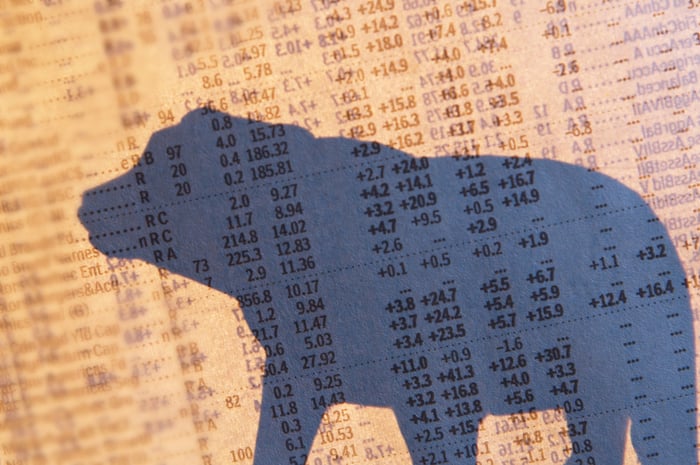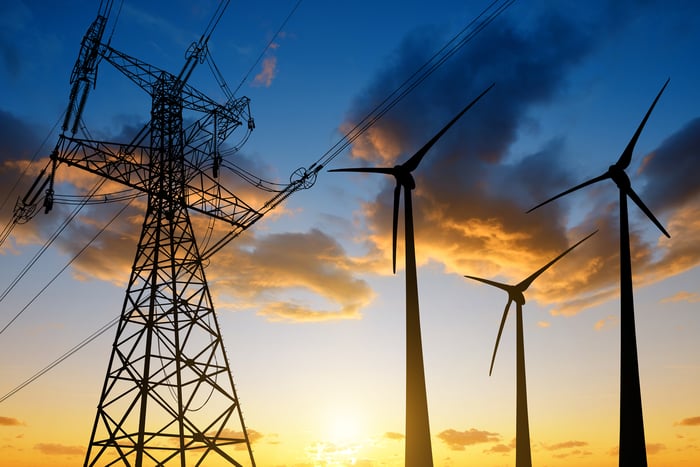It's been a rough year on Wall Street. Since the curtain opened for 2022, the Dow Jones Industrial Average and broad-based S&P 500 have fallen into clear-cut correction territory, with declines topping 10%. Meanwhile, the tech-heavy Nasdaq Composite has shed more than a quarter of its value, firmly placing it in a bear market.
While there are a number of factors to blame for the fall of a major U.S. index into a bear market, such as COVID-19 supply chain disruptions and the war in Ukraine, our nation's central bank deserves its fair share of the blame.
Although overseeing the monetary policy of the largest economy in the world doesn't come with an instruction manual, it's clear, in hindsight, the Federal Reserve left its foot on the accelerator too long (i.e., kept lending rates at historic lows). The end result is a 40-year high for inflation and record-low consumer confidence.

Image source: Getty Images.
But if there's silver a silver lining to Fed-induced bear markets, it's that investors with cash get to do some opportunistic shopping.
Perhaps no strategy is sounder than buying dividend stocks. Companies that regularly pay a dividend are typically profitable on a recurring basis and time-tested. History also shows that income stocks tend to vastly outperform non-dividend-payers over the long term. With this in mind, here are four perfect dividend stocks to buy hand over fist during a Fed-induced bear market.
Enterprise Products Partners: 6.73% yield
The first ideal dividend stock to buy is oil and gas midstream company Enterprise Products Partners (EPD 0.04%). Not only can its 6.7% annual yield put a big dent in historically high inflation, but the company's base annual payout has also increased in each of the past 23 years.
What makes Enterprise Products Partners such an attractive stock is its role within the energy complex. Whereas drilling and exploration companies are somewhat or fully exposed to the wild vacillations of crude and natural gas prices, midstream companies like EPD (this is Enterprise Products Partners' ticker symbol, and an easy abbreviation) are well-protected from price swings. That's because they typically rely on fixed-fee or volume-based contracts. In other words, EPD's annual cash flow is relatively transparent no matter what happens with the spot for crude oil or natural gas.
The other big reason to appreciate EPD is the safety of its payout. During the height of the pandemic, the company's distribution coverage ratio (DCR) never dipped below 1.6. The DCR is a measure of distributable cash flow generated from operations relative to what's disbursed to shareholders. A figure below 1 would signify an unsustainable payout.
With oil and natural gas now hitting multidecade highs, drilling demand is likely to increase in the coming years, further solidifying the health of this juicy payout.
Broadcom: 3.03% yield
Semiconductor solutions specialist Broadcom (AVGO -0.98%) is another no-brainer dividend stock that can be bought hand over fist in a Fed-induced bear market. Broadcom's quarterly payout has increased more than 5,700% since 2010.
If there's a knock against semiconductor stocks, it's that they're cyclical. When the U.S. and global economy weaken, it's pretty much a given that semi stocks will follow. But this is a two-sided coin. Keep in mind that periods of economic expansion last considerably longer than contractions. Over time, buying and holding high-quality semiconductor stocks should lead to sizable shareholder gains.
The big catalyst for Broadcom, at least through the midpoint of the decade, is 5G infrastructure upgrades. Telecom companies are in the midst of making their wireless towers 5G-capable, which should encourage consumers and businesses to upgrade their wireless devices. Since Broadcom generates most of its revenue from wireless chips found in smartphones, this multiyear device replacement cycle should lead to steady operating cash flow growth and reasonably strong pricing power.
Broadcom also ended 2021 with a record backlog of $14.9 billion. Even if the U.S. and global economy weakens, the company has orders booked more than a year in advance. This provides an added level of safety to the company's cash flow.

Image source: Getty Images.
NextEra Energy: 2.13% yield
A third passive income powerhouse to scoop up with Fed policy causing market uneasiness is electric utility stock NextEra Energy (NEE 0.45%). Despite having the lowest yield on this list (2.13%), NextEra has offered some of the strongest returns among utility stocks over the past decade.
Arguably the best thing about utility stocks is the predictability of their cash flow. Regardless of how volatile the stock market gets, homeowners and renters are unlikely to change their electricity consumption habits. This means highly predictable cash flow for NextEra, which comes in handy when the company is outlaying capital for new infrastructure projects and its quarterly dividend.
The true differentiator for NextEra is its renewable energy focus. No electric utility in the U.S. generates more capacity from solar or wind -- and that's unlikely to change. The company has allotted $50 billion to $55 billion for new infrastructure projects between 2020 and 2022. Most of this new infrastructure is tied to cost-lowering green energy.
Although renewable energy projects can be costly on an upfront basis, it's helped sustain a high single-digit growth rate for NextEra Energy for over a decade in a sector known for low single-digit growth.
Sabra Health Care REIT: 8.42% yield
A fourth and final perfect dividend stock to buy hand over fist in a Fed-induced bear market is Sabra Health Care REIT (SBRA -0.85%). At 8.42%, Sabra has the highest yield among the stocks on this list.
As the company's name states, Sabra is a real estate investment trust (REIT) with a healthcare focus. It owns and leases more than 400 aggregate skilled nursing and senior housing facilities in the U.S. and Canada. Although Sabra was clobbered during the COVID-19 pandemic due to concerns about whether or not its tenants would pay their rent, much of that uncertainty has passed. In fact, Sabra notes that 99.5% of forecasted rents were collected since the pandemic began.
Since the beginning of 2021, the occupancy rates for skilled nursing facilities and senior housing communities have rebounding. What's more, Sabra was able to amend its master lease agreement with Avamere, a key tenant which has struggled because of the pandemic. Under the amended agreement, Avamere has more breathing room with its rental payments. However, Sabra has the ability to receive higher rental payments in the future if Avamere's operating performance bounces back in big way.
If you need one more good reason to trust Sabra Health Care, consider this: the U.S. boomer population is aging. Demand for skilled nursing facilities and senior housing communities should climb over the coming decades, which puts Sabra in the driver's seat when it comes to rental pricing power.





